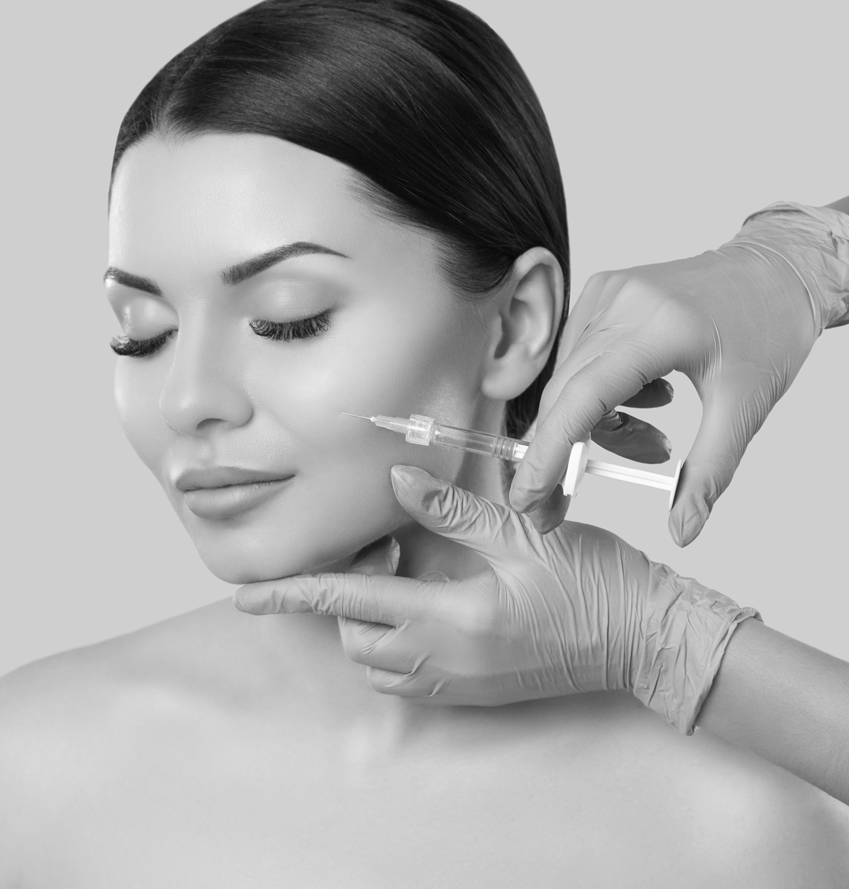What are Dermal Fillers?
If you’d like to restore youthful fullness to your face, enjoy plump lips, enhance shallow contours or soften those facial creases and wrinkles, dermal fillers may be the answer. Dermal fillers have been called “liquid facelifts” because they offer many of the benefits of a surgical facelift without the downtime.
Although they can’t help with excess sagging skin, these soft tissue fillers can add more volume and provide immediate results at a lower cost than surgery. These treatment aren’t permanent, however, and they must be repeated and maintained.
As a board-certified female plastic surgeon in Fort Worth, Dr. Polavarapu often recommends dermal fillers alongside other skin rejuvenation treatments, including Botox injections. Together, these options can help enhance your natural beauty. During your consultation, Dr. Polavarapu will assess your unique needs and suggest a tailored combination of treatments to help you achieve your desired results.

Are Injectable Fillers Right for You?
Dermal fillers are wonderful to rejuvenate your appearance, but they can’t stop the aging process. If you want a permanent solution, talk to your doctor about a facelift, brow lift or eye lift.
Some people opt to have a liquid facelift, delaying the time when a surgical facelift is more appropriate.
It’s a great way to see some impressive changes and improvements in your appearance, such as the reduction of forehead wrinkles, until you’re ready for a permanent surgical option.
Just remember, you’ll need to have repeat treatments with dermal fillers as a wrinkle treatment to maintain that fresh, full new look.
Temporary Fillers
Human fat, also known as autologous fat, is harvested from your own body. Using your own fat requires a more extensive procedure than other injectable fillers because you first must undergo liposuction to extract the fat prior to injection. You eliminate the risk of allergic reaction or rejection by the body by using your own fat. You should know that not all of the live fat cells survive when transplanted into a new site. You can expect a fairly high rate of re-absorption. Because of this, your doctor will likely overfill the area being treated. At first you might look abnormal, but it will soon settle and you’ll enjoy a new look. When your doctor extracts this fat via liposuction, it’s possible that there will be more than is needed for one application. Most natural fat can be stored for touch-ups.
Hyaluronic acid is also a natural substance found in your body. High concentrations are found in soft connective tissue and in the fluid surrounding your eyes. It’s also in some cartilage and joint fluids, as well as skin tissue. If the name sounds familiar, it’s because the same substance is often injected into the aching joints of people with arthritis to ease pain by providing extra cushioning. Hyaluronic acid is not derived from animal sources. Brand names include: Captique, Esthélis, Elevess, Hylaform, Juvéderm, Perlane, Prevelle, Puragen and Restylane.
When injected beneath the skin, these fillers plump up creased and sunken areas of the face. They can also add fullness to the lips and cheeks. Injectable fillers may be used alone or in conjunction with a resurfacing procedure, such as a laser treatment, or a recontouring procedure, such as a facelift.
Planning for Treatment
Facial rejuvenation is very individualized. That’s why it’s important to discuss your hopes and expectations with a board-certified plastic surgeon who has experience with many different types of surgical and non-surgical facial procedures.
In your initial consultation, your plastic surgeon will evaluate your face – the skin, the muscles and the underlying bone – and discuss your goals for the surgery. Your doctor will help you select a treatment option based on your goals and concerns, your anatomy and your lifestyle.
Your surgeon will ask you about your medical history, drug allergies, and check for conditions that could cause problems, such as active skin infections or non-healed sores from injuries.
Insurance usually doesn’t cover cosmetic procedures. However, if your injectable treatment is being performed to treat a scar or indentation from an accident or injury, you may be reimbursed for a portion of the cost. Check with your insurance carrier to be sure.
Injectables are usually administered in a surgeon’s office-based facility. If, however, you are being hospitalized for a facelift, neck lift, brow lift, or any other procedure, your injections may be administered in the hospital as well.
THE PROCESS
What to expect with dermal fillers
First, your surgeon will listen to your desired results and then evaluate your facial appearance and skin tone, examining the areas of your face to be augmented with a cosmetic dermal filler.
Next, the surgeon will mark strategic points on your face as guides to the appropriate injection sites for the filler.
Your injection sites will be cleansed with an antibacterial agent. Then a topical anesthetic will be used to numb the area, particularly if you are sensitive to injections. In some cases, the dermal filler includes an anesthetic in the mixture.
Both the donor and recipient sites are numbed with local anesthesia. Sedation can be used as well. If you elect to use sedation, be sure to arrange for a ride home after your treatment.
The actual injections will take just a few minutes total, and just seconds per site.
The marks will be washed away and you will be offered an ice pack to reduce any minor and temporary discomfort. At this point you may apply makeup, but be careful not to apply pressure to the treated areas. Doing so may result in movement of the dermal filler. Read more about aftercare following dermal filler treatments >>
A special note about scars and deep lines: these areas will often require multiple injections to achieve your desired results. If a deeper injection is required, you’ll be offered a local anesthetic to remain comfortable. Common sites for deeper tissue fillers are the nasolabial folds and marionette lines, or to enhance fullness in the cheeks.
If you’re like most patients, you’ll be very satisfied with the results of your injectable treatments. You may be surprised at the pleasing results that can be gained from this procedure.

Risks Related to Injectables
When injectables are administered by a qualified plastic surgeon, complications are infrequent and usually minor in nature. Still, individuals vary greatly in their anatomy, their physical reactions and their healing abilities. The outcome of treatment with injectables is never completely predictable.
Hyaluronic Acid: side effects are typically mild or moderate in nature and last for less than 7 days. Adverse events include redness, pain, firmness, swelling, lumps/bumps, bruising, itching, and discoloration.
Risks not necessarily related to allergies include infection, abscesses, open sores, skin peeling, scarring and lumpiness, which may persist over the treated area. Reports of these problems are very rare.
Fat: Allergic reaction is not a factor for fat because it’s harvested from a patient’s own body. However, there is still a small risk of infection and other infrequent complications.
Dermal Fillers Fort Worth FAQs
Dermal fillers are a collection of injectable medications that boost the appearance of your skin, plump hollowed areas, and add youthful firmness. At Polavarapu Plastic Surgery, Dr. Polavarapu offers a variety of fillers, including Juvéderm®, Belotero®, RADIESSE®, and the Restylane® family of products.
Many of these fillers contain a compound known as hyaluronic acid, which occurs naturally in your body. Production of hyaluronic acid declines as you age, resulting in sagging skin and more evident wrinkles.
When injected with dermal fillers, your skin rehydrates, plumps, and looks more youthful. Other fillers contain calcium hydroxylapatite, which provides immediate volume as soon as it’s injected and stimulates your body to produce natural skin-strengthening compounds.
Dermal fillers can be helpful in reducing the signs of aging by smoothing out moderate-to-severe wrinkles and folds and restoring plumpness in certain areas. The specific issues Dr. Polavarapu may address with these injectable products include:
- Nasolabial folds
- Parentheses lines and marionette lines
- Tiny lines around the lips
- Acne scars
- Lip augmentation
- Cheek volume
- Volume on backs of hands
Dr. Polavarapu examines your skin and considers your aesthetic goals when recommending the best type of filler for your needs. She may use a combination of products to achieve the type of youthful appearance you desire.
Most patients tolerate the application of dermal fillers quite well. They’re administered via a fine needle to your face, so expect to feel a pinch during treatment. Dr. Polavarapu offers a topical anesthetic prior to treatment, and some fillers include an anesthetic in their formula. You may be offered ice following treatment to ease any immediate discomfort.
Following the injections, you may have some redness, swelling, and bruising at the injection sites for a few days. These side effects resolve quickly and can be masked with makeup.
The positive effects of dermal fillers last anywhere from six months to two years. Exactly how long they last depends on how your body processes the filler, the type of product used, and the area treated. Lip-plumping injections that improve your lips’ shape and volume last typically about six months while wrinkle-reducing effects may persist longer.
To keep up the effects of dermal fillers, you need to repeat the injections. Dr. Polavarapu can put you on a regular treatment schedule, so you don’t notice a change in your look between retreatments.
To learn about the positive effects of dermal fillers, call the office of Polavarapu Plastic Surgery or book an appointment online today.
*Individual results may vary




